
Davis, Aron. The Poker Blueprint
.pdf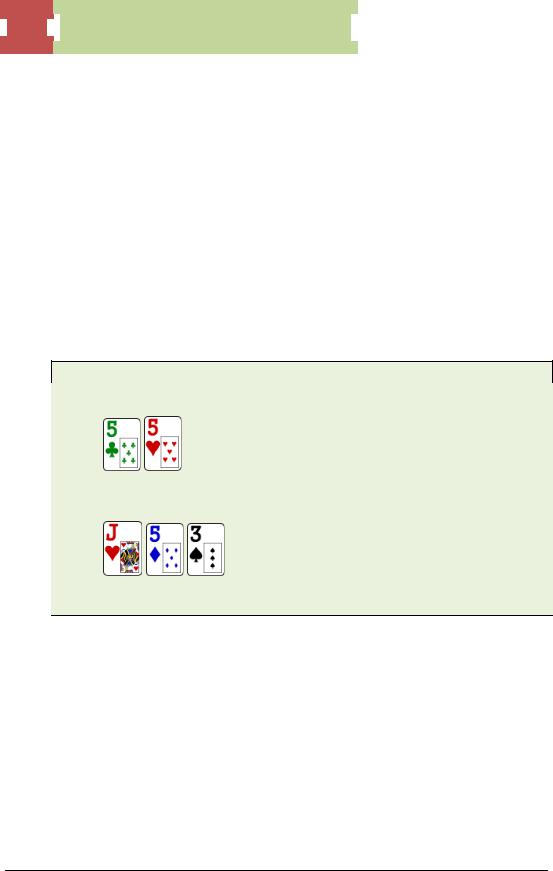
 109
109  Postflop: Time to Play Poker
Postflop: Time to Play Poker
Check-Raising
Slow-play on dry boards; play fast on wet boards.
Check-raising is a profitable move that should be in every good player’s arsenal. However, we don’t want to blindly check-raise the flop and hope it works. There are a few factors we should consider before check-raising.
1.The strength of your hand
2.Board texture
3.Villain’s perception of your range and check-raising tendencies
4.Villain’s c-betting frequency
5.The range of hands that Villain will go broke with
100 NL – 6 max. 100BB effective stacks.
A good LAG player open raises to $3 on the button. You call from SB with
The flop is
You check and he bets $5 into $7. You raise to $21.
Using the guidelines from before:
1.Your hand is very strong.
2.The board is so dry that you don’t have to worry about getting outdrawn.
3.You are capable of check-raising this flop with KQ and 67. However, he likely doesn’t know that. So when you check-raise, he will think you have sets or AJ.
4.On this flop texture, Villain is probably c-betting with a high frequency.
5.Villain will probably go broke with AJ+.
Based on the above analysis, calling is the most optimal play here. The main reason is because he doesn’t know you are capable of check-raising light on this flop. Thus, it is unlikely that he’s calling your check-raise with a weak holding or playing back with air. If
© 2010 Aaron Davis and Tri Nguyen - All Rights Reserved.
http://www.DailyVariance.com
109
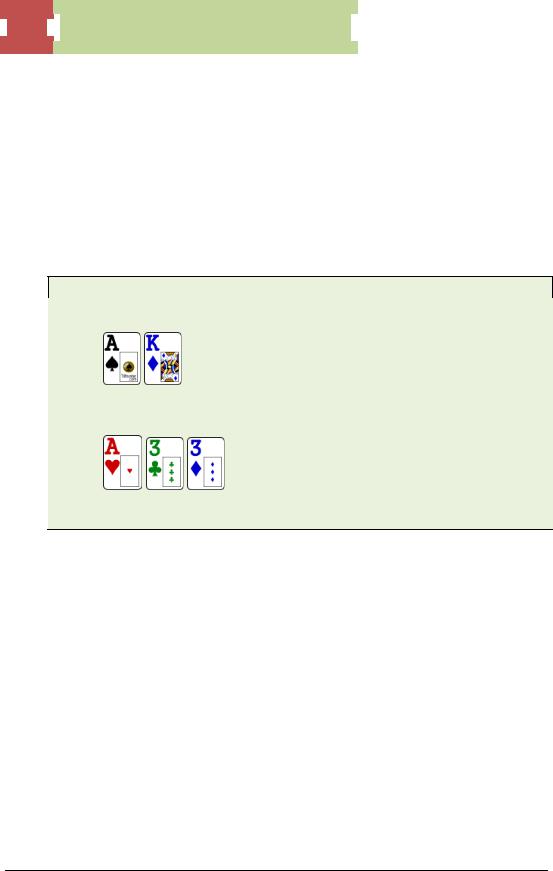
 110
110  Postflop: Time to Play Poker
Postflop: Time to Play Poker
you have been caught check-raising this flop with hands such as KQ, 67, or A2s, then check-raising with a strong hand such as 55 is a better line because he is less likely to believe you.
Check-calling Villain’s c-bet is also profitable because Villain will continue bluffing on a broadway turn and will continue value-betting with Jx or better. In both situations you are getting one more street of value.
Let’s look at some less obvious examples.
100 NL – 6 max. 100BB effective stacks.
A good LAG player open-raises to $4 from the BTN and you call with
from the BB for deception. The flop is
You check and he bets 2/3-pot. You should …
Raise. He’s going put you on a bluff a large percentage of the time because your value range is very narrow. AA, 33, and A3s wouldn’t check-raise the flop. 3x suited (besides A3s) is unlikely as well because you would have folded those hands to a pre-flop praise. He could put you exactly on AK or AQ, but that’s being optimistic since people rarely call pre-flop raises with AK from the blinds. More often than not, Villain will put you on a bluff and call you down light or bluff-raise you. You also want to build the pot in case he has Ax or a stubborn TT-KK hand.
On to the next hand:
© 2010 Aaron Davis and Tri Nguyen - All Rights Reserved.
http://www.DailyVariance.com
110
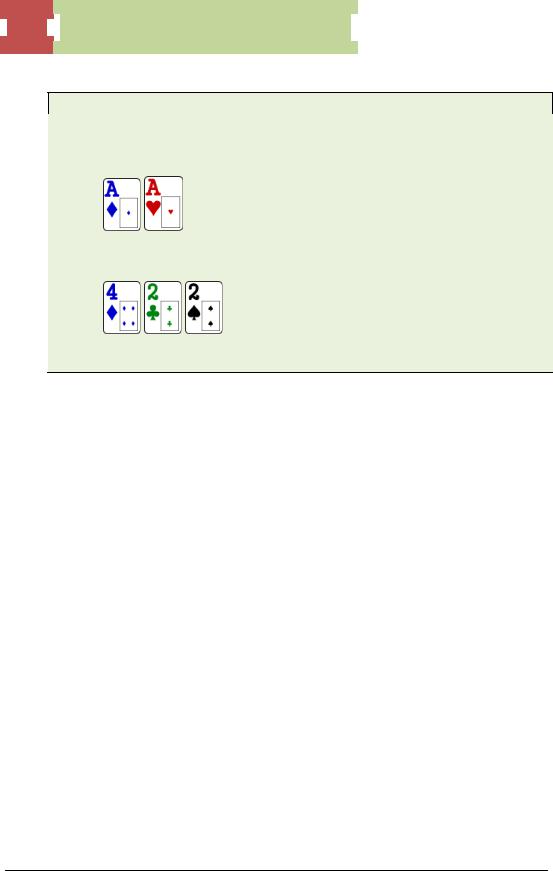
 111
111  Postflop: Time to Play Poker
Postflop: Time to Play Poker
100 NL – 6 max. 100BB effective stacks.
A decent TAG player open-raises to $3 from BTN. You have some history with him and he doesn’t respect your plays. You pick up
and decide to just call. The flop is
and you check-raise his c-bet.
With your history, he will have a hard time folding and may even go broke with midpocket pairs. The check-raise looks very bluffy (although you know better than to checkraise bluff on these types of boards against stubborn opponents). There are not many hands that you can check-raise for value with.
If he calls, then bet the turn. If he 3-bets the flop, then raise and get it in. You don’t want a scare card to come on the turn and have him fold a hand like TT. An argument can be made that by 4-betting the flop, we are giving Villain a chance to fold and thus, play correctly. However, the times that he will stack off light on this flop with a pair far outweigh instances when he has air and folds to our 4-bet.
One last hand:
© 2010 Aaron Davis and Tri Nguyen - All Rights Reserved.
http://www.DailyVariance.com
111
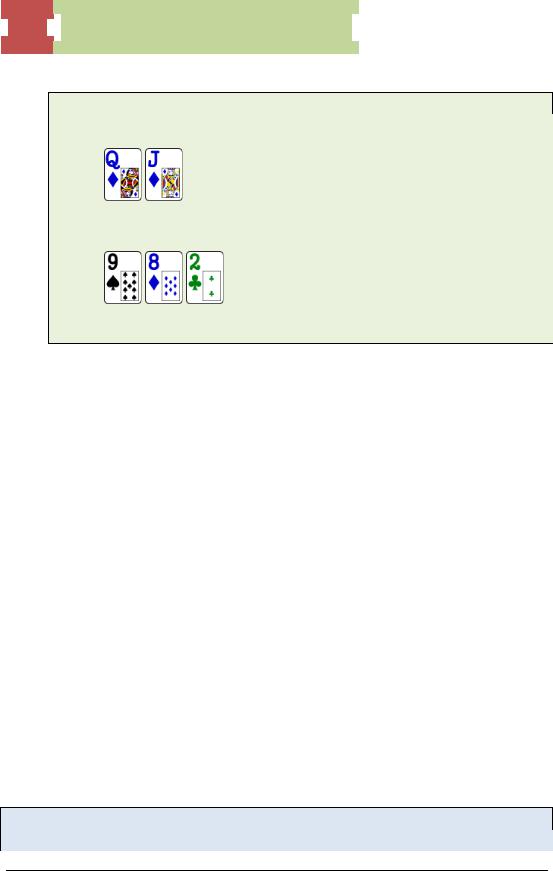
 112
112  Postflop: Time to Play Poker
Postflop: Time to Play Poker
100 NL – 6 max. 100BB effective stacks.
The CO open-raises to $4 and you call from the BB with
The flop is
and you check-raise him.
While you currently have only Q-high and a gutshot, you also have a backdoor flush draw, backdoor straight draw and overcards. Many turn cards will improve your equity or give you the winning hand. You can continue your aggression with any diamond. I will likely follow through on a turn ace as well since Villain is likely to have a straight draw or a small pair that will fold on the turn. If the turn is a ten, jack, queen, or king I will continue betting.
An argument can be made for check-calling when the turn is a ten, jack, queen, or king and that is if our opponent floats the flop a lot. In such a situation we want to give our opponent a chance to bluff on the turn so that we can extract more value from our hand.
We aren’t afraid of getting outdrawn that often because if Villain has a straight draw, his outs will likely improve our hand as well.
In this example you will often need to fire the second barrel to win. That’s fine. You will fold out a lot of 8x hands and some 9x hands on the turn, taking down the dead money along the way. Being able to check-raise on the flop with a wide range helps you to gain more value on your strong hands and makes you tougher to play against.
Important Note: Don’t go crazy and start check-raising all dry boards when you have some equity. Target the right opponents. Players who c-bet more than 75 percent of the
© 2010 Aaron Davis and Tri Nguyen - All Rights Reserved.
http://www.DailyVariance.com
112
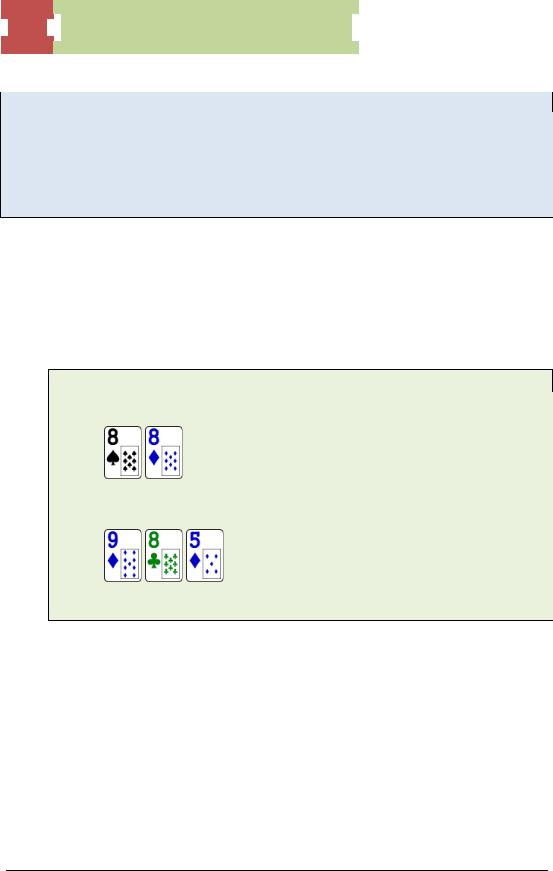
 113
113  Postflop: Time to Play Poker
Postflop: Time to Play Poker
time are good targets to start with. Players who call too loosely are not. Similar to 3- betting pre-flop, you’ll want to keep putting the pressure on a player until he gives you a reason not to. If he keeps folding to your check-raises, then don’t stop. When he does fight back (by 3-betting your check-raise or calling you down lighter), simply decrease your check-raising frequency and have more strong hands in your range. Poker is about making adjustments, and it’s easier to adjust when you are the original aggressor.
Check-Raising for Value
To extract the most value when you check-raise with a strong hand, you should do it in situations where your perceived range is wide. For this reason, check-raising on a wet flop will get you more calls than on a dry flop.
For example:
100 NL – 6 max. 100BB effective stacks.
The CO open-raises to $3.50 and you call with
from the SB. The flop is
You check. He bets 3/4-pot and you check-raise.
This is a great spot to check-raise for value because you can have a lot of draws in your check-raising range. Whether you check-raise with draws or not in this spot is irrelevant because your opponent doesn’t know. When he faces a check-raise on this board, he is trying to construct a range for you and he will put straight and flush draws in your range. Of course, he will also take into account two pair, sets and straights. But because there are draws in your range, his stack-off range is lighter than if the board was rainbow.
Another reason for check-raising this flop is that there are a lot of turn cards that can slow down the action and prevent you from stacking him. For example, Villain will get it in on the flop with 98, 55, big diamonds, and QQ+. If the turn comes a diamond, a six, a seven, a ten, or a jack, both of you will slow down considerably.
© 2010 Aaron Davis and Tri Nguyen - All Rights Reserved.
http://www.DailyVariance.com
113
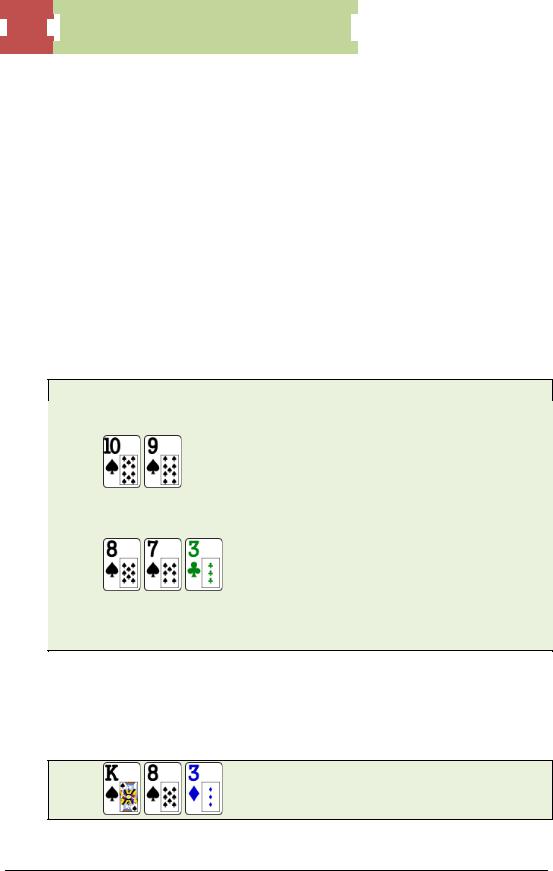
 114
114  Postflop: Time to Play Poker
Postflop: Time to Play Poker
It’s also good to check-raise for balance. This is a great spot to check-raise an opponent who c-bets too much. So, having some nut hands in your range makes Villain more willing to give you credit when you check-raise with a hand such as 77, QJ, and 87.
If you don’t know how to construct a check-raising range, start off with only the nuts in your range and see how your opponent reacts to your check-raise. If you are getting a lot of folds, start adding draws with eight or more outs. If you still get a lot of folds, add some gutshots to your range. If you find that your opponent is calling you light or playing back more often, you can drop draws from your check-raising range and add more value hands such as top pair, good kicker or overpairs that you flatted with pre-flop. The key is to be conscious of what your check-raise means to your opponent and adjust your range accordingly.
A quick example:
100 NL – 6 max. 100BB effective stacks.
An unknown player open-raises to $3 on the BTN and you call from the BB with
The flop is
He c-bets $4 into $6.50, and you check-raise.
Check-raise here with your open-ended, straight-flush draw with overcards 100 percent of the time to maximize your fold equity against a hand like 99. If he calls or shoves, you still have tons of outs. Against aces, you have 54-percent equity. Let’s say you have the same hand but the flop is
© 2010 Aaron Davis and Tri Nguyen - All Rights Reserved.
http://www.DailyVariance.com
114

 115
115  Postflop: Time to Play Poker
Postflop: Time to Play Poker
Then a check-call is much better because your equity goes way down against top pair. Now, if villain is a NIT and folds to check-raises all the time, then go ahead and checkraise. Although it sucks if he ends up 3-betting the flop, you will get him to fold hands such as QQ-99 and sometimes a hand as strong as K9. However, as a default, I would check-call on this flop.
Important Note: No matter how much information I give you, you have to go out and try it for yourself. By actively thinking about your range in any situation, you will be more aware of your opponent’s range and his tendency. Ultimately, it is up to you as poker player to determine how to fit those pieces together. That comes with practice and observation.
Check-Raising the Turn
Several years ago, a play called “stack-a-donk” was very popular. This is where you raise pre-flop, bets the flop, check the turn to induce a bet, and then raise all in (usually with an overpair). It was extremely effective back then because players kept betting with their topand mid-pair when checked to on the turn. They also couldn’t fold them to a checkraise. Once pot control became the new mantra, it became less effective because players started checking behind more often with marginal holdings.
In microand small-stakes games where your opponents aren’t as observant, you can have an unbalanced turn check-raise range with only the nuts and monster draws and get away with it. However, as you move up in stakes, you will realize that constructing a balanced turn check-raising range is very difficult. It makes it very difficult to two-barrel effectively if your opponents know that you have a tendency to check-raise the turn with the nuts. Even if you don’t check-raise the nuts often, your opponent may misread your frequency and call your two barrel lighter. Of course, the way you adjust is to stop betting the turn with air. However, I want to make my life easier by having a simpler overall game plan. I would bet the majority of my nut hands to balance the times I’m betting with air.
For borderline situations where my hands are marginal, I can bet, check-call or check-fold, depending on my opponents.
If my opponent floats a lot, I will check-call the turn more often than folding. I will also check-call the turn with the nuts instead of check-raising, and will check-call or checkraise the river, depending on whether I still have a strong hand by the river.
If my opponent has a tendency to pot-control, I will check-call the turn as well because that means his betting turn range is polarized to floats, draws, and nut hands. If I check-
© 2010 Aaron Davis and Tri Nguyen - All Rights Reserved.
http://www.DailyVariance.com
115
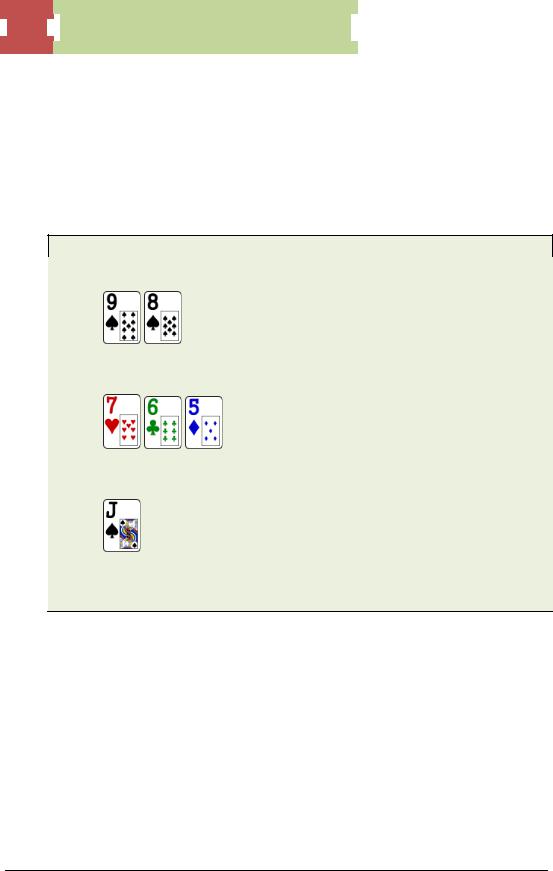
 116
116  Postflop: Time to Play Poker
Postflop: Time to Play Poker
call and don’t improve on the river, unless I have a specific read, I will check-fold to a river bet.
Having said that, there are spots where a turn check-raise is applicable as you move up. They usually involve deep stacks.
For example:
100 NL – 6 max. 200BB effective stacks.
You c-bet with
on
The turn is a
You should highly consider check-raising here to get more money in so you have about a pot-sized river bet.
Opponents rarely float on such a flop. If they will call your turn bet, they will bet if checked to with the majority of made hands such as two pair, sets, straights, and sometimes overpairs. Of course, there are times when opponents will check back with hands such as 88-TT and 87, and you can get value from those hands with a river bet.
Usually, if you check the turn with a strong hand and it gets checked through, you should check the river as well. Betting the river after checking the turn seems like an obvious value-bet. However, this flop hits a decent part of Villain’s range, so he almost always have a hand that will call a river bet but would check behind a lot.
Check-Raising the River After a Missed Turn Check-Raise (For Value)
© 2010 Aaron Davis and Tri Nguyen - All Rights Reserved.
http://www.DailyVariance.com
116
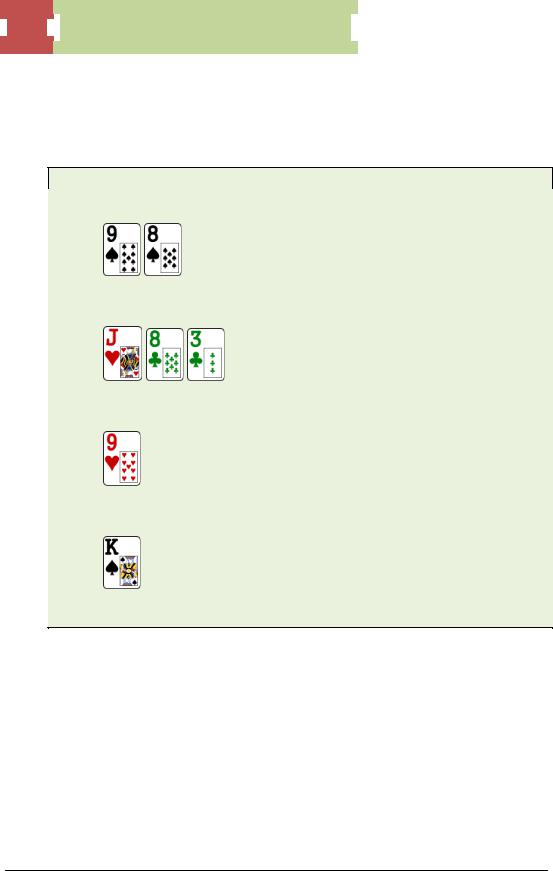
 117
117  Postflop: Time to Play Poker
Postflop: Time to Play Poker
So you missed the turn check-raise because he checked behind. What should your line be on a “scary” river? Go for the check-raise again.
Let’s go over the following example.
100 NL – 6 max. 100BB effective stacks.
The CO open-raises to $4 and you call with
from the SB. The flop is
and you check-call a pot-sized bet. The turn is a
You check, and he checks behind. The river is a
What is your action? Check or bet?
Check. Look at your line from his perspective. After your check-call the flop, your range is mostly Jx, 8x, straight draws and flush draws. You are probably check-raising the flop with AJ+ and strong combo draws to get more money in. The river is the perfect card for him to try to take down the pot against your range. Betting the river prevents him from bluffing with his air and missed draws. You are going to get value from AK/KQ by betting or checking. For these reasons, checking is infinitely better than betting. One argument for betting is that it protects the time you show up on the river with a missed draw and want to bluff at the pot. While this is true, considering that Villain didn’t bet on the turn, he likely has ace-high and will fold to a river bet. As exploitable as that sounds, that’s how players play.
© 2010 Aaron Davis and Tri Nguyen - All Rights Reserved.
http://www.DailyVariance.com
117

 118
118  Postflop: Time to Play Poker
Postflop: Time to Play Poker
Important note: We intentionally left out river check-raise bluffs because it’s an advanced
play that will likely get you in trouble. Once you improve and play 200nl+, then you can
add that play to your game.
© 2010 Aaron Davis and Tri Nguyen - All Rights Reserved.
http://www.DailyVariance.com
118
